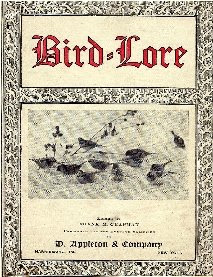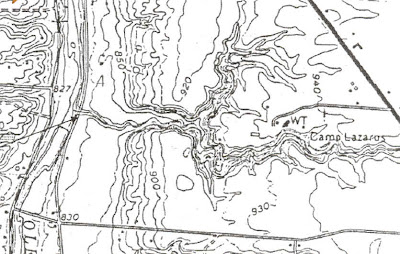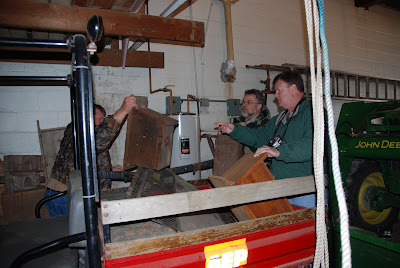Intrepid naturalists joined me in a mix of rain and snow for a geology walk at the Ross County Park District's Earl H.
Barnhart Buzzards' Roost Nature Preserve, overlooking
Yocatangee Gorge(1) March 22, 2008. Annually, we ponder the complex geology of this glacial boundary region while searching for harbingers of spring.

Naturalists puzzling over the geology of
Yocatangee Gorge; the remarkable gorge of Paint Creek west of
Chillicothe, Ross County, Ohio. Historian Kevin Coleman, left, with Gary McFadden, resident naturalist, viewing distant Paint Creek from a
Berea Sandstone ledge along the south rim of the gorge*.

Dark crumbly
Sunbury Shale is found exposed atop thick tabular
Berea Sandstone along the gorge rim.
Berea Sandstone forms the superstructure holding the rim in place. Hardy Virginia pine (
Pinus virginiana) colors the gorge rim with green highlights, year-round.

Chestnut oak (
Quercus prinus) is common on dry hilltops, and it's a dominate near the rim of the gorge on gentle slopes of
Sunbury Shale. The rim is a harsh dry habitat during the heat of summer. Chestnut oak thrives on dry acid slopes, too harsh for many tree species.

Detail of deeply furrowed chestnut oak bark.

A wintergreen native orchid, Adam and Eve, a.k.a.
puttyroot (
Aplectrum hyemale), gathers sunshine when trees and most leaf-eating insects are dormant.
Puttyroot is common in the wooded uplands of Buzzards' Roost Nature Preserve. Its green winter leaves are distinctive. Their prostrate habit and dry papery texture, resembling recently wilted dead leaves, may be adaptations to discourage grazing. The leaves will disappear as other plants leaf out. A solitary stalk will rise and flower later in spring.

Crippled
cranefly (
Tipularia discolor) is another fairly common wintergreen native orchid found in wooded uplands at Buzzards' Roost. The green leaves are thicker than
puttyroot leaves, broad chordate (heart-shaped base), warty, and deep-purple underneath. The purple color comes from
anthocyanins, pigment compounds that protect leaf cells like a sunscreen and may absorb heat, speeding chemical processes making sugars. The color may also signal
unpalatability to grazers. Like
puttyroot,
cranefly orchid leaves disappear as other plants leaf out. Later in spring a solitary flowering stalk will bloom with
cranefly-resembling flowers.
 Cutleaf grapefern
Cutleaf grapefern (
Botrychium dissectum) is a
winterbronze fern common on wooded and old field uplands of Buzzards' Roost, but often overlooked. Its succulent leaves blend with leaf litter.
Cutleaf grapefern is lime green as it sprouts in fall, bronzing with freezing weather, overwintering, greening again in warm spring, and sending up a fruiting stalk late in spring before disappearing in summer heat.

Blocky "alligator skin" bark of common persimmon (Diospyros virginiana). This tree grew from underneath an old wooden sty where a mammal may have carried fruits from another tree nearby, leaving the seeds behind to grow up through the old wooden structure. The sty has been demolished, leaving the interesting tree.

Vernal pools and small ponds on "The Roost" are busy with breeding amphibians. Jefferson's salamander eggs, spotted salamander eggs, and wood frog eggs are abundant. Underwater egg masses are visible inside the observer's shadow.
Puzzling over geology...
A jig-saw puzzle missing many of its pieces and without a reference picture on a box-top would be declared a lost cause, the pieces thrown away by all but the most determined
puzzleers. Now mix these random pieces with those of several other puzzles strewn in the bottom of a child's toy box and you have a useless collection of squiggly pieces-parts, by any reasonable standard. Even so, extreme
puzzleers can't resist the challenge.
Yet, sorting these commingled puzzles into comprehensible images is child's-play compared with piecing together a view of the complex geological history of a place like
Yocatangee Gorge, the gorge of Paint Creek just west of
Chillicothe, Ohio.
Geology is a puzzle on a grand scale; a four-dimensional solution (three dimensions plus time) found without the benefit of a reference picture. It's a series of puzzles, really; a puzzle assembled from other puzzles. The solution is a time-lapse video, not a static image. Even simple landscapes tell convoluted stories. Every piece of each geology puzzle is as much a process as a material, and more inference than absolute. Most pieces of the original puzzles are missing, eroded away, lost in time like grains of sand in a mighty Ohio River flood. You can never really know if you have re-assembled geology puzzles correctly: and someone else will surely declare your solutions imperfect, no matter how comprehensive your effort. Nevertheless, the journey is a joy for the geologist-
puzzleer.
A grand puzzle of stream piracy...
Yocatangee Gorge is a grand puzzle resulting from stream piracy(2), but how?. The existence of this new narrow gorge of Paint Creek, cut through a particularly hilly section of the Allegheny Plateau, makes no sense in terms of casual landscape logic(3), until we consider the impact of major glaciations. This beautiful gorge, and others found along Ohio's glacial boundary, are the result of at least two
Icehouse climates(4), major glacial episodes in Earth's history.
Yes: The two most recent glaciations, the Wisconsin and the Illinoisan glaciations, were important formative events making the new gorges near the glacial boundary in southern and central Ohio. But, I'm not referring just to these fairly recent events of the Pleistocene. I'm suggesting a very ancient origin for parts of the
Yocatangee Gorge puzzle(5), at least 350 million years old, a direct result of a Paleozoic glacial age during the Lower Mississippian Epoch of the Carboniferous; a Pleistocene-like time when continental glaciers smothered large areas of Earth long before the Pleistocene, near the beginning of the coal age. An up to date chart.pdf detailing the Geological Time Scale is found at
Stratigraphy.org.
The shape of the gorge...
Look at the topographic map of the gorge seen here at
1:200,000 scale. The small red cross-hairs are centered on the map at the entry to the gorge.
Chillicothe is seen at right. Route 50 is a bold red line trending SW to NE through the old broad valley of Paint Creek at left, the flattish white area. If you are new to topographic maps, just remember to see steep slopes wherever the brown squiggly lines are close together; where they are far apart, see flattish ground. The steep slopes and hills often are forested, indicated by green shading.
Now, zoom in to
1:50,000 scale to see more detail where the stream leaves its broad valley and enters the hills. You will notice right away that Paint Creek occupies a really broad mature valley along Route 50 as it flows northeastward. Abruptly, the creek turns, flowing southeastward among steep hills, through a young "V" shape gorge. WHY?
Some bedrock background...
Ohio exhibits pancake sedimentary bedrock geology. There is a 'basement' of mostly very old igneous and metamorphic rocks buried deep below a 'superstructure' of Paleozoic sedimentary rocks; multiple layers of flattish to somewhat tilted
limestones, sandstones, and
shales. And, a 'roof' of glacial deposits covering most bedrock in the northwestern two-thirds of the state. The layers of
Paleozoic sedimentary bedrock are stacked like pancakes leaning on a breakfast plate margin. The pancake layers are exposed edgewise north to south through central and eastern Ohio as seen in the
Bedrock Geological Map of Ohio. The layers dip toward the east just a few degrees in central Ohio.
Yocatangee Gorge offers a view of Ohio's Devonian and Mississippian pancake geology and of deep time spanning 365 million years.
To be continued...
Notes:
*The gorge rim is a limited-access area reserved for science and interpretive programs offered by scheduled naturalists. Visitors, please don't approach the sensitive gorge rim. Stay on leaf litter well away from the edge. Foot traffic is erosive and destructive of rim-slope plants. Many rim rocks are thin sandstone block overhangs vulnerable to failure.
(1) "
Yocatangee" is a name I have proposed for this deep gorge of Paint Creek found a few miles west of
Chillicothe in Ross County, Ohio. The connection of the gorge with the Native American "
Yocatangee" will be the subject of a future blog entry. The name derives from maps summarizing features noted in early surveys; contact-period names and descriptions applied to features in southern Ohio. These are from two sources: The first, a map of "Indian Villages..." and other features by Lewis, G. L. and
Dawley, W., 1901, and the second from notations on Peter
Kalm's Travels map of 1771. Today, the gorge is commonly called "Alum Cliffs" or "Alum Cliffs Gorge" or "Paint Creek Gorge." The former name is found on topographic maps, the latter name often results in confusion with the beautiful western Ross County gorge of Paint Creek cut into limestone and dolomite, now mostly flooded by Paint Creek Lake Dam.
(2)
Stream piracy results when a stream intersects a second stream, diverting the second stream's drainage through the first streams channel, pirating the second streams water. Stream piracy occurs frequently as landscapes mature. Most stream piracy results from
headward erosion. The headwaters of streams continually progress
headward (the direction opposite the current flow-direction) by an erosive process bringing more and more elevated terrain into slope toward the stream through down-cutting, a high energy process where stream gradients are steep. The piracy of ancient Paint Creek resulted through a different process involving glacial lake formation and spillway down-cutting where the deepening lake
breached a col between hills: Spill-over piracy. The earliest description (of which I'm aware) of spill-over piracy proposed for this gorge is described and illustrated by Jesse E. Hyde in
Camp Sherman Quadrangle, 1921, Geological Survey of Ohio Fourth Series Bulletin 23.
(3)
Landscape logic is applied common sense. Landforms evolve slowly through steady predictable processes, and occasionally by sudden changes like volcanoes, landslides and glaciations. Formative factors like rock type, climate, and elevation operate in predictable ways. Geologists often speculate on the evolution of landscapes by applying landscape logic.
(4)
Icehouse climates are major cold periods of Earth climate during which series' of continental glaciations dominated temperate and polar regions for spans of millions of years. There were at least four
Icehouse climate regime's prior to the the most recent, the Pleistocene.
(5)
The Yocatangee Gorge puzzle solution attributing
Bedford Shale and
Berea Sandstone
silici-
clastic deposition to Devonian-Mississippian
glacio-
eustatic response, I present herein, has not been published in peer-reviewed literature and remains speculative (as far as I know-I'm not very active in research geology): Certainly, there are timing issues to work out more carefully. This solution was inspired by carbon isotope work suggesting a
Kinderhookian-
Osagean chill, like the work of
Saltzman at The Ohio State University, a growing consensus around
glacio-
eustatic causation for Carboniferous and Permian cyclic sediments-the coal measures, and particularly by a published re-interpretation of the
Blackhand Sandstone (Hocking Hills) as an incised-fill resulting from
glacio-
eustatic sea level changes with Lower Mississippian glaciations, a West Virginia University PhD dissertation by David L.
Matchen, 2004.
 Bird-Lore, the "official Audubon Societies publication" at the turn of the 19th Century
Bird-Lore, the "official Audubon Societies publication" at the turn of the 19th Century Topographic map of Lazarus Run and Deer Run, Delaware County, Ohio. Lazarus Run courses east-west. Deer Run joins from the north. The Olentangy River at far left.
Topographic map of Lazarus Run and Deer Run, Delaware County, Ohio. Lazarus Run courses east-west. Deer Run joins from the north. The Olentangy River at far left. Jim McCormac, OOS President, pointing out a commanding hilltop on The Wilds where AEP ReCreation Lands staff will mount an elevated perch for birds of prey. The flag marks a roadside location for a kestrel box pole.
Jim McCormac, OOS President, pointing out a commanding hilltop on The Wilds where AEP ReCreation Lands staff will mount an elevated perch for birds of prey. The flag marks a roadside location for a kestrel box pole. Checking out International Road, The Wilds, to locate kestrel boxes and raptor perches at optimal positions. Left to right: Cheryl Harner, OOS conservation committee; Tom Bain, OOS committee chair; Al Parker, Education professional and naturalist at The Wilds; and Jim McCormac, OOS President and conservation committee member. Jim put the pieces in place for this partnership success. Al Parker will help install poles and work the constructions into the fascinating mission of The Wilds.
Checking out International Road, The Wilds, to locate kestrel boxes and raptor perches at optimal positions. Left to right: Cheryl Harner, OOS conservation committee; Tom Bain, OOS committee chair; Al Parker, Education professional and naturalist at The Wilds; and Jim McCormac, OOS President and conservation committee member. Jim put the pieces in place for this partnership success. Al Parker will help install poles and work the constructions into the fascinating mission of The Wilds. Checking out old nest boxes for second life opportunities at AEP's Windy Hill ReCreation Lands facility. Jim McCormac, right; your blogger, middle; and Dave Dingey, of AEP, left. Dave Dingey is making it happen by bringing AEP's resources and manpower to the mission.
Checking out old nest boxes for second life opportunities at AEP's Windy Hill ReCreation Lands facility. Jim McCormac, right; your blogger, middle; and Dave Dingey, of AEP, left. Dave Dingey is making it happen by bringing AEP's resources and manpower to the mission. A Pleistocene Serengeti: A scene that might have been plucked from the Pleistocene wilds of Ohio just decades after deglaciation, found at The Wilds.
A Pleistocene Serengeti: A scene that might have been plucked from the Pleistocene wilds of Ohio just decades after deglaciation, found at The Wilds.
 Big Muskie, a giant drag-line excavator, dwarfs its bucket. The bucket is seen at the end of the cables below ground level in this illustration displayed at Miner's Memorial Park. A series of mounted illustrations walk visitors through the 20th Century history of surface mining in southeastern Ohio.
Big Muskie, a giant drag-line excavator, dwarfs its bucket. The bucket is seen at the end of the cables below ground level in this illustration displayed at Miner's Memorial Park. A series of mounted illustrations walk visitors through the 20th Century history of surface mining in southeastern Ohio.